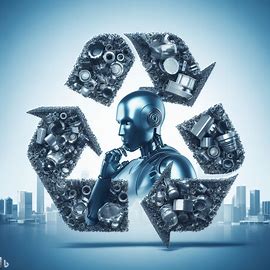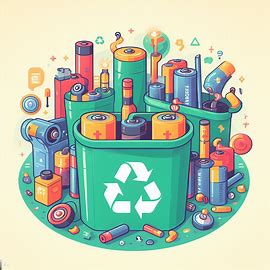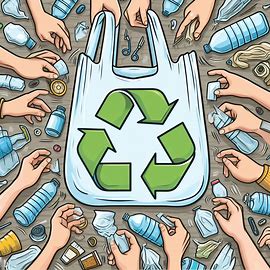In a world grappling with the environmental consequences of rapid industrialization, metal recycling emerges as a beacon of sustainability. Metal, known for its durability and versatility, is one of the most recyclable materials on the planet. This comprehensive guide dives into the importance of metal recycling, shedding light on the environmental benefits, the recyclability of various metals, the recycling process, and how individuals and businesses can actively contribute to this eco-friendly practice. Discover the transformative power of metal recycling and join the global movement towards a greener, more sustainable future.
The Importance of Metal Recycling
The importance of metal recycling cannot be overstated in the context of contemporary environmental concerns. Metal recycling plays a pivotal role in mitigating the adverse impact of industrial processes on our planet. Here are key reasons highlighting the significance of metal recycling:
Conservation of Natural Resources:
Metal extraction from ores involves extensive mining and processing, leading to habitat destruction and environmental degradation. By recycling metals, we reduce the demand for new raw materials, conserving precious natural resources such as iron, aluminum, copper, and more.
Energy Efficiency:
The energy required to extract metals from their ores is significantly higher than the energy needed for the recycling process. Recycling metals, particularly aluminum, helps conserve energy. For instance, recycling aluminum consumes only about 5% of the energy required for primary production, contributing to a substantial reduction in greenhouse gas emissions.
Reduction in Greenhouse Gas Emissions:
Metal production, especially from primary sources, is associated with the release of greenhouse gases. Recycling metals helps cut down on these emissions, as the processes involved in recycling generally emit fewer pollutants compared to primary production methods.
Waste Reduction:
Metals are durable and do not degrade over time. When disposed of in landfills, they contribute to long-term environmental issues. Recycling diverts these metals from landfills, extending the lifespan of disposal sites and reducing the environmental impact of waste.
Preservation of Ecosystems:
Mining activities often lead to habitat destruction, soil erosion, and water pollution. By recycling metals, we minimize the need for new mining operations, preserving ecosystems and protecting biodiversity.
Economic Benefits:
Metal recycling contributes significantly to the economy by creating jobs in the recycling industry, fostering innovation in recycling technologies, and reducing production costs for manufacturers who use recycled metals.
Global Resource Security:
Recycling helps alleviate dependence on finite resources concentrated in specific geographic regions. This promotes global resource security by diversifying the sources of essential metals and reducing geopolitical tensions related to resource access.
Closed-Loop System:
Metal recycling operates on a closed-loop system, where recycled metal can be repeatedly reprocessed without significant loss of quality. This circular approach minimizes waste and fosters a sustainable, cyclical use of materials.
In summary, metal recycling is a powerful strategy for addressing environmental challenges associated with industrialization. By embracing this practice, individuals, industries, and governments can contribute to the conservation of resources, energy efficiency, waste reduction, and the overall well-being of our planet.
Recyclable Metals
Ferrous vs. Non-Ferrous Metals
Understanding the distinction between ferrous (iron-based) and non-ferrous metals is essential for effective recycling. Common ferrous metals include steel and iron, while non-ferrous metals encompass aluminum, copper, brass, and more.
Most Recycled Metals
Highlight the metals that are most commonly recycled, such as aluminum, steel, and copper. Explain their recyclability rates and the wide range of products they can be transformed into.
The Metal Recycling Process
Collection
Explore the initial step of metal recycling, where scrap metal is collected from various sources, including households, industries, and construction sites. Discuss the importance of proper collection methods to ensure the purity of the materials.
Sorting and Processing
Detail the sorting process, where different metals are separated based on their properties. Discuss the use of advanced technologies in processing to enhance efficiency and purity.
Melting and Purification
Explain how the sorted metals are melted down to remove impurities, resulting in high-quality recycled metal that can be used in manufacturing.
Benefits of Metal Recycling
Economic Impact
Discuss the economic advantages of metal recycling, including job creation, reduced production costs for manufacturers, and the growth of the recycling industry.
Waste Reduction
Highlight the role of metal recycling in waste reduction, emphasizing the importance of diverting metal from landfills to extend the lifespan of these disposal sites.
How to Recycle Metal: Tips for Individuals and Businesses
Recycling metal is a straightforward yet impactful way for both individuals and businesses to contribute to environmental sustainability. Here are practical tips for incorporating metal recycling into daily practices:
For Individuals:
- Separate Metals from General Waste: Create a designated bin for metal items at home. Ensure that metals such as aluminum cans, steel food containers, and other recyclable metal objects are separated from general waste.
- Know Your Local Recycling Guidelines: Familiarize yourself with the metal recycling guidelines provided by your local recycling facility. Different areas may have specific rules regarding the types of metal accepted and the proper way to prepare materials for recycling.
- Utilize Curbside Recycling Programs: Take advantage of curbside recycling programs if available in your community. Many municipalities offer curbside pickup for recyclables, including metals. Follow the guidelines provided by your local waste management services.
- Find Nearby Recycling Centers: Identify local recycling centers that accept metal. Some facilities offer drop-off points for various metals, making it convenient for individuals to contribute to recycling efforts.
- Participate in Community Recycling Events: Stay informed about community recycling events where you can bring collected metal items for proper disposal. These events may offer additional incentives or educational resources about recycling.
- Educate Others: Spread awareness about the importance of metal recycling within your community. Encourage friends, family, and neighbors to adopt recycling practices and share information on local recycling options.
For Businesses:
- Implement an Internal Recycling Program: Establish a comprehensive recycling program within your business. Provide clearly marked bins for metal recycling in common areas, break rooms, and production areas to make it easy for employees to participate.
- Conduct Waste Audits: Regularly assess your business’s waste generation through waste audits. Identify opportunities to reduce, reuse, and recycle metal materials within your operations.
- Train Employees: Educate employees about the importance of metal recycling and provide training on proper recycling practices. Ensure that everyone understands which metal items are recyclable and where recycling bins are located.
- Partner with Recycling Service Providers: Collaborate with local recycling service providers to streamline the recycling process. Establish partnerships with companies that specialize in collecting and processing metal waste.
- Invest in Recycling Infrastructure: Consider investing in on-site recycling infrastructure if feasible. Having dedicated equipment for sorting and processing metal waste can enhance efficiency and make recycling a seamless part of your business operations.
- Monitor and Report Recycling Metrics: Track and report the success of your metal recycling efforts. Share progress with employees and stakeholders to highlight the positive environmental impact and encourage continued participation.
- Explore Product Packaging Alternatives: Evaluate your business’s use of metal packaging and explore sustainable alternatives. Consider packaging materials that are easier to recycle or have a lower environmental impact.
By integrating these tips into daily practices, individuals and businesses can play a significant role in promoting metal recycling, contributing to a more sustainable and environmentally conscious future.
Conclusion:
In conclusion, metal recycling is a powerful tool in the fight against environmental degradation. By understanding the recyclability of different metals, supporting efficient recycling processes, and actively participating in metal recycling initiatives, individuals and businesses can contribute to a more sustainable future for our planet. Embracing metal recycling not only conserves valuable resources but also paves the way for a cleaner and healthier environment for generations to come. Start your metal recycling journey today and be a part of the positive change our planet desperately needs.







